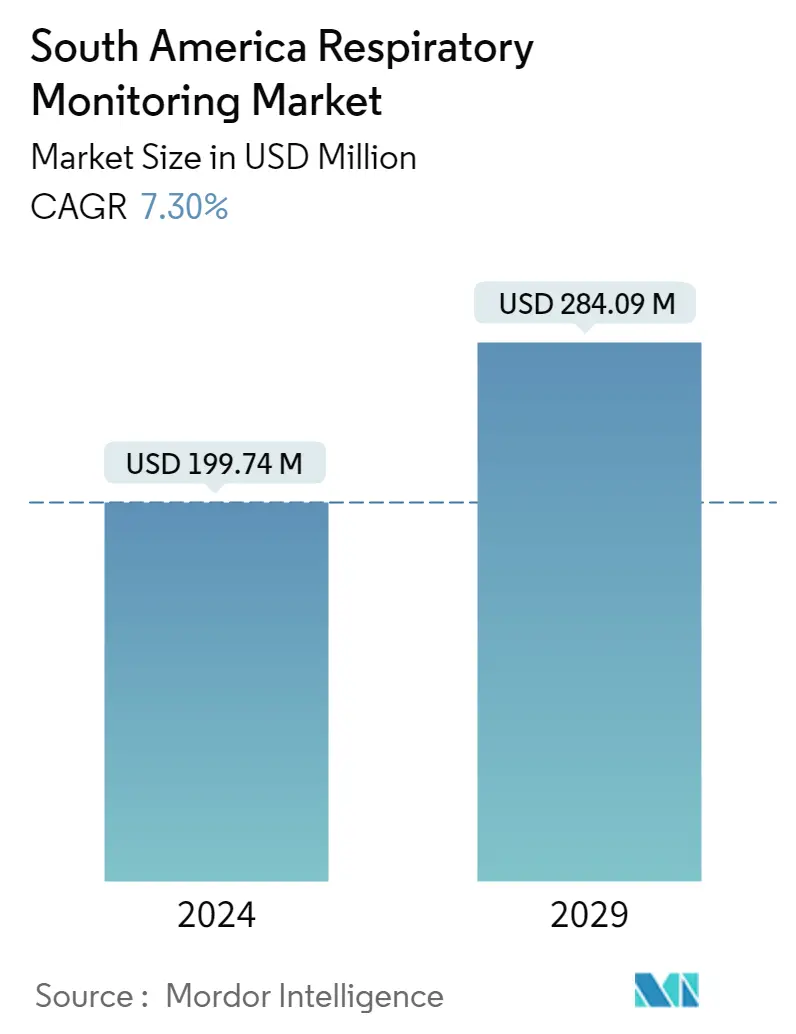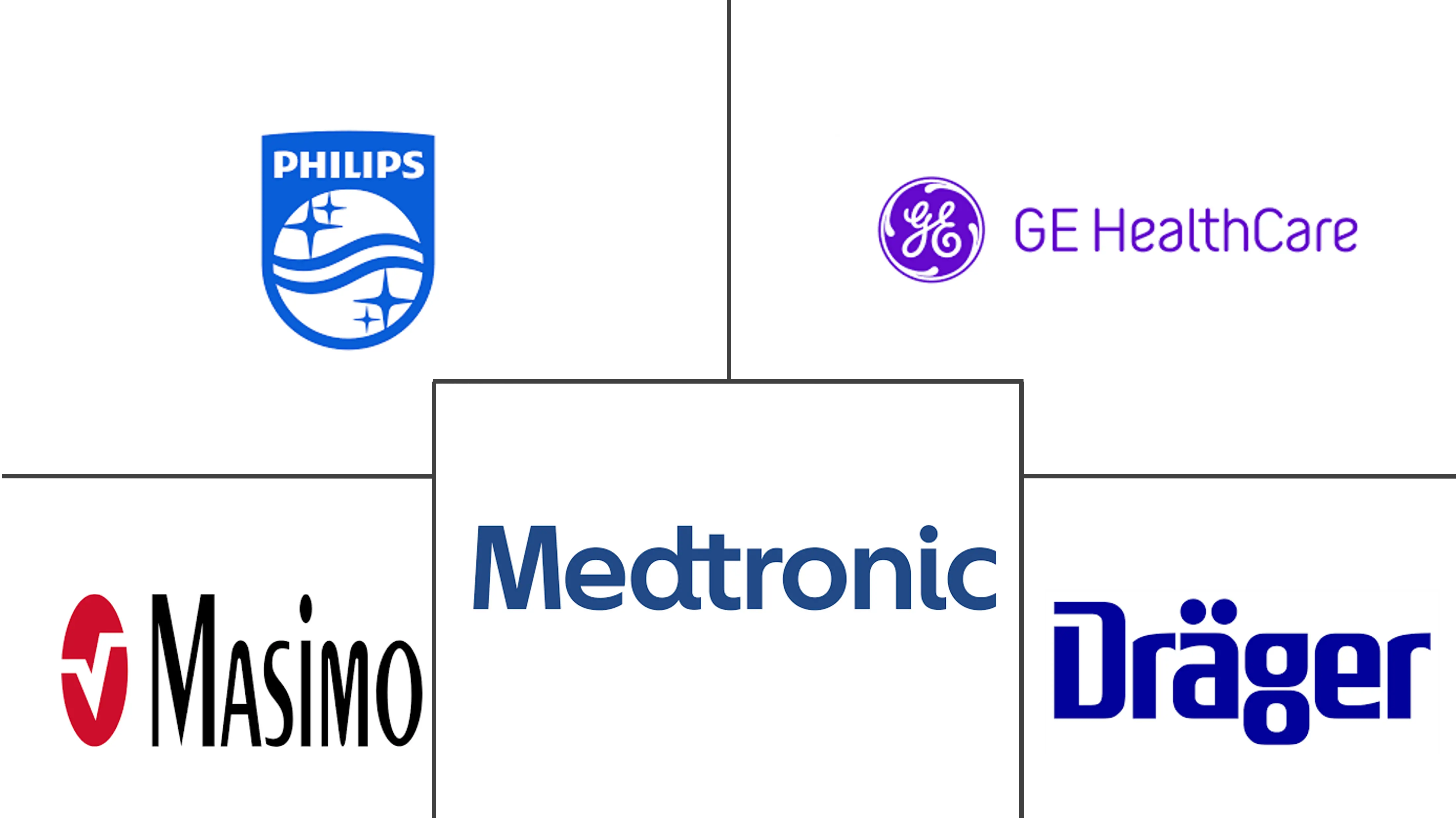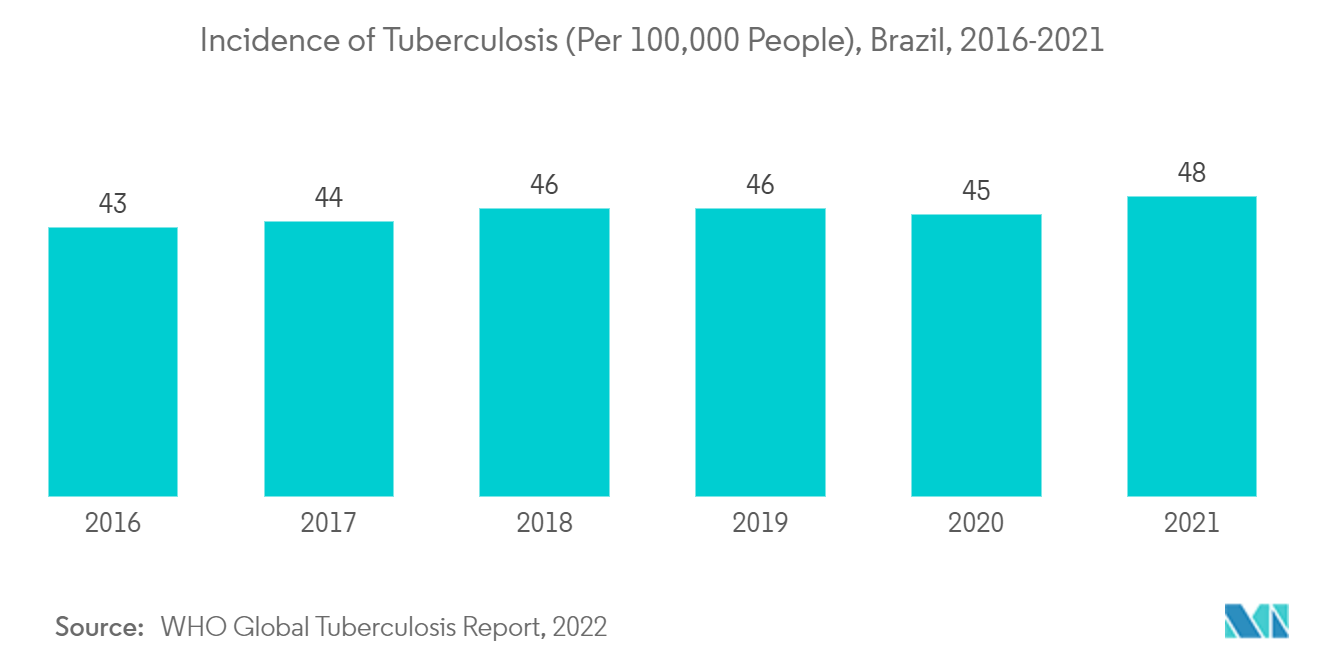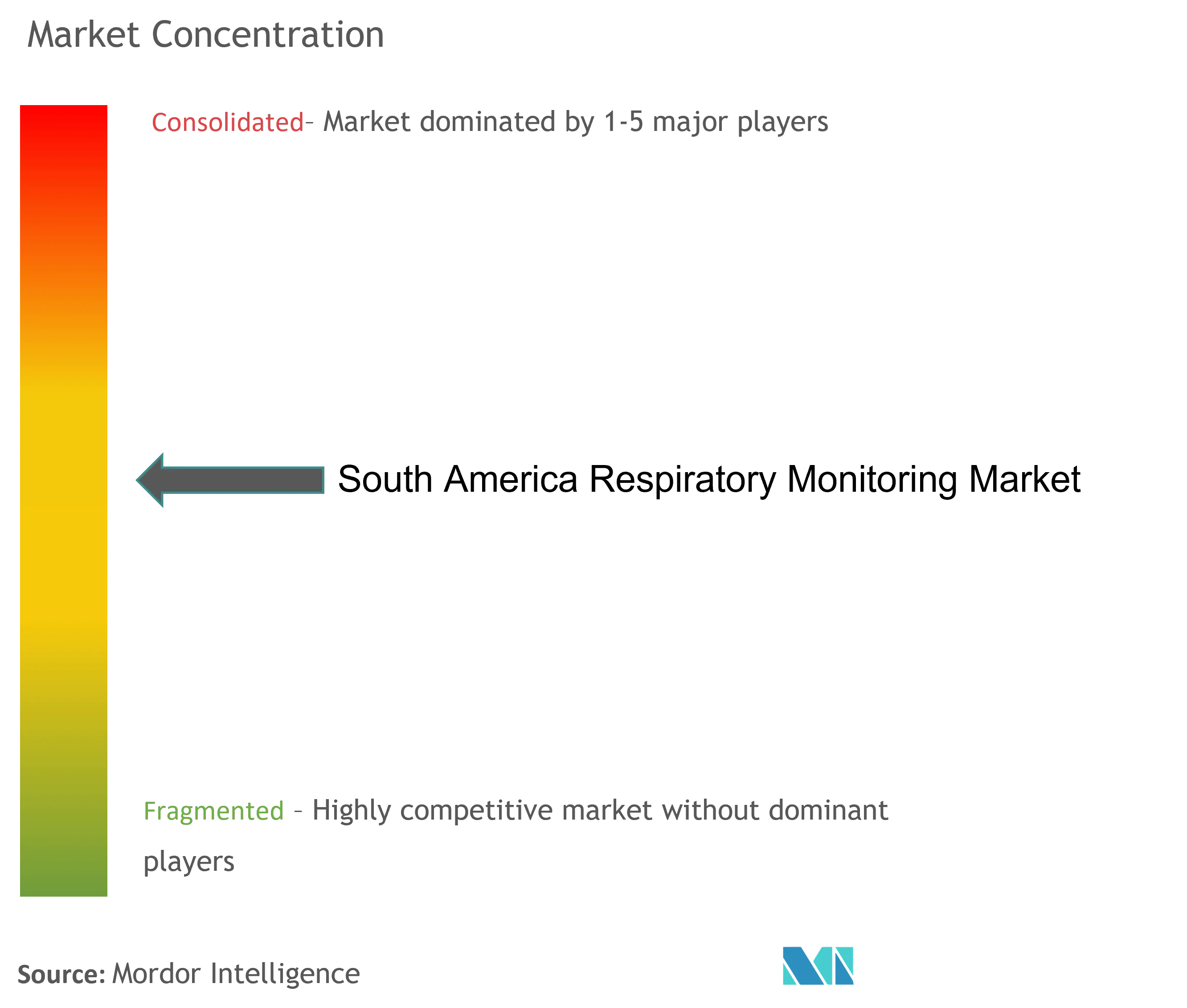South America Respiratory Monitoring Market Size

| Study Period | 2019 - 2029 |
| Base Year For Estimation | 2023 |
| Forecast Data Period | 2024 - 2029 |
| Market Size (2024) | USD 199.74 Million |
| Market Size (2029) | USD 284.09 Million |
| CAGR (2024 - 2029) | 7.30 % |
Major Players
*Disclaimer: Major Players sorted in no particular order |
South America Respiratory Monitoring Market Analysis
The South America Respiratory Monitoring Market size is estimated at USD 199.74 million in 2024, and is expected to reach USD 284.09 million by 2029, growing at a CAGR of 7.30% during the forecast period (2024-2029).
- The COVID-19 pandemic impacted the respiratory monitoring market significantly. The demand for respiratory monitoring devices has witnessed significant growth during the pandemic due to the increasing number of COVID-19 cases that require continuous respiratory monitoring. As per the study published in MDPI Journal in June 2021, lower CO2 levels were associated with an increased risk of death in COVID-19 patients. Hence, analysis of the capnogram became useful for tracking CO2 levels in COVID-19 patients. Thus, increasing demand for capnograms for monitoring CO2 levels in COVID-19 patients drove the market over the pandemic. According to an article published in the American Journal of Public Health in August 2022, South America turned out to be one of the most vulnerable areas to the pandemic because of regional disparities in health capacities, weak health authority, and structural and historical inequalities that undergird social determinants of health.
- The major factors driving the market's growth include:
- The rise in the prevalence of respiratory diseases.
- A high prevalence of tobacco smoking.
- The development of advanced technologies in respiratory monitoring devices.
- COPD is prevalent in South America owing to multiple factors, such as increased cigarette smoking, exposure to tobacco smoke, and high air pollution. According to a systematic review and meta-analysis published by National Center for Biotechnology Information in 2021, the prevalence of COPD from 37 studies was 7.6%, and pooled prevalence from 26 spirometry estimates was 8.9%. The high prevalence of respiratory disease and tobacco smoking are expected to increase the demand for respiratory monitoring, eventually driving the market over the forecast period.
- Therefore, the increasing prevalence of respiratory diseases has augmented the demand for early diagnosis. All these factors are expected to drive the South American respiratory monitoring market over the forecast period. However, reimbursement concerns and the high cost of monitoring devices are expected to restrain the market's growth.
South America Respiratory Monitoring Market Trends
Pulse Oximeter Segment is Expected to Witness High Growth Over the Forecast Period
- A pulse oximeter is a non-invasive medical device that measures an individual's blood oxygen saturation by attaching a sensor to a finger, toe, or earlobe and using spectrophotometry to calculate the percentage of oxygenated hemoglobin pulsating through a network of blood capillaries. The increasing prevalence of respiratory diseases, the growing geriatric population, and the rising need for portable monitoring devices are expected to drive the market for pulse oximeters in the region. According to the World Bank World Population Prospects: 2022 Revision, the population aged 65 and above in Latin America and the Caribbean was 58.84 million in 2021 and 57.21 million in 2020.
- In addition, the need for pulse oximeters increased to monitor hypoxia due to the COVID-19 pandemic and the rise in the prevalence of respiratory diseases. For instance, in January 2021, the Stavros Niarchos Foundation (SNF), as part of its global COVID-19 relief initiative, partnered with Lifebox to provide hundreds of pulse oximeters to healthcare providers working on the frontline during the COVID-19 pandemic in Asia, Africa, and Latin America. Furthermore, pulse oximetry's ease of use and low cost is anticipated to propel the segment's growth over the forecast period.
- Thus, the pulse oximeters segment is anticipated to have considerable demand over the forecast period due to the abovementioned factors.

Brazil is Expected to Dominate the South America Respiratory Monitoring Market
- Chronic diseases, including chronic obstructive pulmonary disease (COPD) and tuberculosis, are leading diseases in morbidity and mortality in Brazil. Smoking is also contributing to the growth of the respiratory devices market. According to the OECD statistics, the percentage of the population aged 15+ years who smoke daily in Brazil was 9.1% in 2021. Significant tobacco usage as cigarette smoking increases the risk of respiratory diseases like asthma and COPD. As per the World Health Organization (WHO) Global Tuberculosis Report published in October 2022, the incidence of tuberculosis in Brazil was reported to be about 48 per 100,000 people in 2021. Thus, a high prevalence of smoking and an increased incidence of tuberculosis are anticipated to drive the market in Brazil over the forecast period.
- Furthermore, a high incidence of acute respiratory diseases is also anticipated to drive the market in the country. For instance, according to a research article published in Frontiers in Microbiology in July 2022, 2,740,272 patients were hospitalized due to severe acute respiratory infection (SARI) in Brazil. Thus, Brazil is anticipated to dominate the South American respiratory monitoring market.

South America Respiratory Monitoring Industry Overview
The South American respiratory monitoring market is slightly consolidated in nature due to the presence of several global companies operating in the region. The competitive landscape includes an analysis of a few global companies which hold significant market shares, including Medtronic Plc, Dragerwerk AG, Nihon Kohden Corporation, Koninklijke Philips NV, Masimo, GE Healthcare, Becton, Dickinson and Company, and others.
South America Respiratory Monitoring Market Leaders
-
Dragerwerk AG
-
Koninklijke Philips N.V.
-
Medtronic Plc
-
Masimo
-
GE Healthcare
*Disclaimer: Major Players sorted in no particular order

South America Respiratory Monitoring Market News
- July 2021: JBS GLOBAL donated seven thousand oximeters to the Department of Health of the São Paulo state government.
- May 2020: Biologix, a Brazil-based sleep apnea home diagnostic and monitoring system manufacturer, developed a portable sensor to monitor COVID-19 patients remotely.
South America Respiratory Monitoring Market Report - Table of Contents
1. INTRODUCTION
1.1 Study Assumptions and Market Definition
1.2 Scope of the Study
2. RESEARCH METHODOLOGY
3. EXECUTIVE SUMMARY
4. MARKET DYNAMICS
4.1 Market Overview
4.2 Market Drivers
4.2.1 Rise in the Number of Chronic Obstructive Pulmonary Disease Patients (COPD), Asthma, TB, etc.
4.2.2 High Prevalence of Tobacco Smoking
4.3 Market Restraints
4.3.1 Reimbursement Concerns
4.3.2 High Price of the Monitoring Devices
4.4 Industry Attractiveness - Porter's Five Force Analysis
4.4.1 Threat of New Entrants
4.4.2 Bargaining Power of Buyers/Consumers
4.4.3 Bargaining Power of Suppliers
4.4.4 Threat of Substitute Products
4.4.5 Intensity of Competitive Rivalry
5. MARKET SEGMENTATION (Market Size by Value - USD million)
5.1 By Type of Device
5.1.1 Spirometers
5.1.2 Peak Flow Meters
5.1.3 Sleep Test Devices
5.1.4 Gas Analyzers
5.1.5 Pulse Oximeters
5.1.6 Capnographs
5.1.7 Other Types of Devices
5.2 By Geography
5.2.1 Brazil
5.2.2 Argentina
5.2.3 Rest of South America
6. COMPETITIVE LANDSCAPE
6.1 Company Profiles
6.1.1 Medtronic PLC
6.1.2 Dragerwerk AG
6.1.3 Nihon Kohden Corporation
6.1.4 Becton, Dickinson and Company
6.1.5 Hamilton Medical
6.1.6 ResMed
6.1.7 Koninklijke Philips NV
6.1.8 GE HealthCare
6.1.9 Nonin
6.1.10 Masimo
- *List Not Exhaustive
7. MARKET OPPORTUNITIES AND FUTURE TRENDS
South America Respiratory Monitoring Industry Segmentation
As per the report's scope, respiratory monitoring devices help monitor various respiratory disorders. These devices diagnose acute or chronic respiratory diseases by determining the respiratory capabilities of the lungs. Several respiratory tests are designed to observe the efficiency of the lungs in exchanging respiratory gases and identify obstructions in the respiratory tract. The South American respiratory monitoring market is segmented by type of device (spirometers, peak flow meters, sleep test devices, gas analyzers, pulse oximeters, capnographs, and other types of devices) and geography (Brazil, Argentina, and the Rest of South America).
The report offers the value (in USD million) for the above segments.
| By Type of Device | |
| Spirometers | |
| Peak Flow Meters | |
| Sleep Test Devices | |
| Gas Analyzers | |
| Pulse Oximeters | |
| Capnographs | |
| Other Types of Devices |
| By Geography | |
| Brazil | |
| Argentina | |
| Rest of South America |
South America Respiratory Monitoring Market Research FAQs
How big is the South America Respiratory Monitoring Market?
The South America Respiratory Monitoring Market size is expected to reach USD 199.74 million in 2024 and grow at a CAGR of 7.30% to reach USD 284.09 million by 2029.
What is the current South America Respiratory Monitoring Market size?
In 2024, the South America Respiratory Monitoring Market size is expected to reach USD 199.74 million.
Who are the key players in South America Respiratory Monitoring Market?
Dragerwerk AG, Koninklijke Philips N.V. , Medtronic Plc, Masimo and GE Healthcare are the major companies operating in the South America Respiratory Monitoring Market.
What years does this South America Respiratory Monitoring Market cover, and what was the market size in 2023?
In 2023, the South America Respiratory Monitoring Market size was estimated at USD 186.15 million. The report covers the South America Respiratory Monitoring Market historical market size for years: 2019, 2020, 2021, 2022 and 2023. The report also forecasts the South America Respiratory Monitoring Market size for years: 2024, 2025, 2026, 2027, 2028 and 2029.
South America Respiratory Monitoring Industry Report
Statistics for the 2024 South America Respiratory Monitoring market share, size and revenue growth rate, created by Mordor Intelligence™ Industry Reports. South America Respiratory Monitoring analysis includes a market forecast outlook to 2029 and historical overview. Get a sample of this industry analysis as a free report PDF download.



